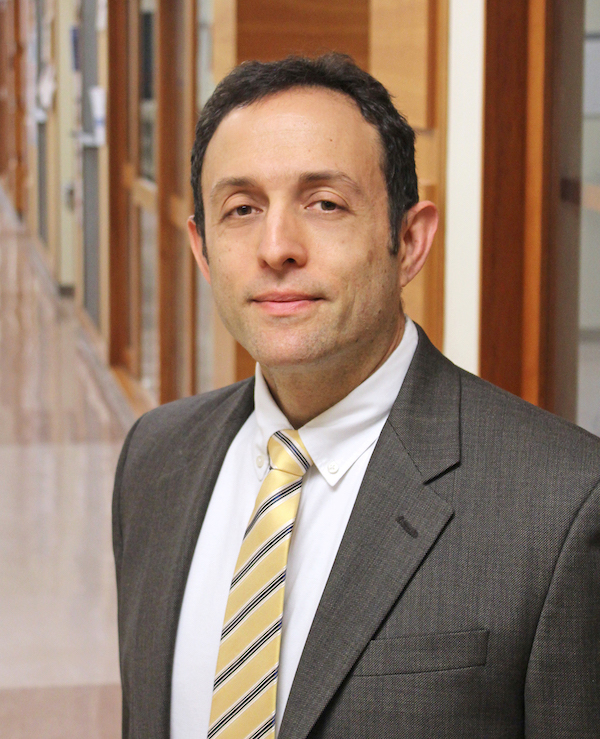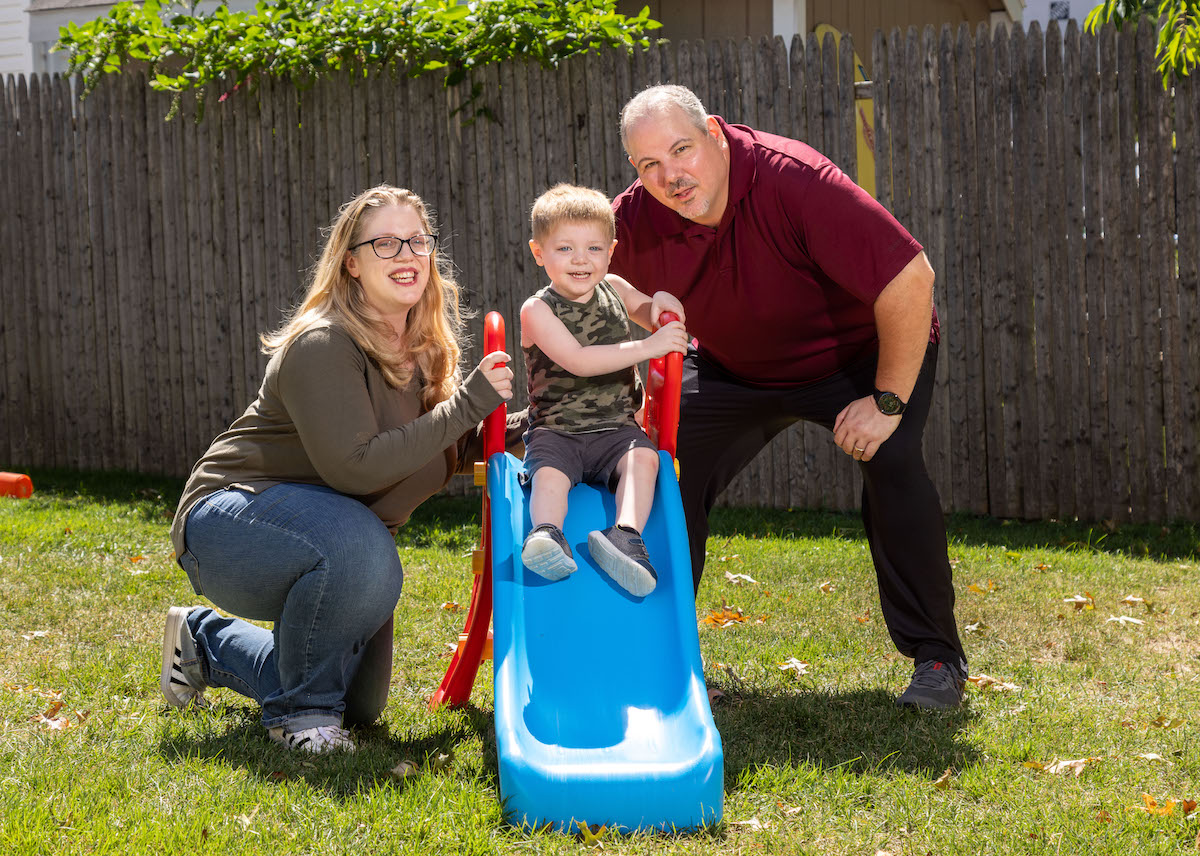
Story by Mary Ann Littell • Portraits by John O'Boyle Subscribe to Cancer Connection
Jimmy Tansey is a bundle of energy. He likes pizza, puppies, books, and movies: anything from “Bolt” and “Up” to Marvel action films. Friendly and social, he started daycare at three months. He loves playing with other kids, and usually greets them saying something like, “Hi! Blocks? Blocks?” In many ways, he’s a typical three-year-old.
But in other ways, Jimmy is not typical at all. At his young age he is already a survivor. In April 2021 he was diagnosed with acute lymphocytic leukemia (ALL), a cancer of the bone marrow that can spread quickly anywhere blood flows, including the lymph nodes, liver, brain, spinal cord, and other organs.
The Tanseys explained how Jimmy’s cancer showed up last spring in an unexpected way. “We saw he was getting a little bit of a belly,” says Lisa, his mother. “His stomach bulged. He’s a tall, lean kid - he’d never had this before.” Lisa also noticed something else that didn’t seem right: Jimmy’s diapers were frequently dry when she changed him. His daycare center picked up on this too and commented about it.
A medical editor, Lisa knows her way around the internet. “I Googled his symptoms, but couldn’t find anything specific,” she says.

James and Lisa Tansey (above) enrolled their son Jimmy in a clinical research study being offered at The Cancer Institute of New Jersey. Under the care of Peter Cole, MD, chief of the Division of Pediatric Hematology/Oncology and Embrace Kids Foundation Endowed Chair in Pediatric Hematology/Oncology at Rutgers Cancer Institute of New Jersey, Jimmy was in remission after a participating in the study for a month.
A week or two later, Jimmy’s belly was even more pronounced, and now it was rock-hard. “He was groaning,” says Lisa. “Clearly, he was uncomfortable.”
They went to their pediatrician. Taking one look at Jimmy, she sent them straight to the emergency room at Monmouth Medical Center, an RWJBarnabas Health facility. Lisa called James so he could meet them there. He works as the southern region IT manager for RWJBarnabas Health, so he was on-site.
There, the hospital team catheterized Jimmy, emptying his full bladder. “You could see the relief on his face,” says Lisa. Then he had a myriad of tests. Hours later, a pediatric hematologist/oncologist from Monmouth Medical Center and Rutgers Cancer Institute came in to speak with them.
“I thought she’d say, ‘Go home, everything’s fine,’” says Lisa. But James braced himself. Through his work, he knows many of the RWJBarnabas Health physicians and administrators. Earlier that evening, a few of the administrators stopped by Jimmy’s room to chat. James sensed a level of hidden concern.
“The doctor told us Jimmy had leukemia,” says Lisa somberly. “We were devastated. I still get emotional just thinking about this. I fell to the floor and cried. Then I stood up and asked, ‘Ok, what do we have to do?’”
James recalls his effort to remain calm. “Our physician tried to reassure us,” he says. “She said if you’re going to get a diagnosis like this, it’s the best kind of cancer to have at his age. It’s very treatable with a high cure rate. Hearing her say that made me feel better, that somehow, we’d get through this.”
Jimmy was transported by ambulance to New Brunswick, to The Bristol-Myers Squibb Children’s Hospital (BMSCH) at Robert Wood Johnson University Hospital, another RWJBarnabas Health facility. Jimmy’s treatment would be under the care of Peter Cole, MD, chief of the Division of Pediatric Hematology/Oncology and Embrace Kids Foundation Endowed Chair in Pediatric Hematology/Oncology at Rutgers Cancer Institute of New Jersey.
Through the partnership between Rutgers Cancer Institute and RWJBarnabas Health, Dr. Cole leads a unified pediatric hematology/oncology program of 14 clinicians who provide care for children with cancer and blood disorders across the state at Monmouth Medical Center, Newark Beth Israel Medical Center, and Rutgers Cancer Institute/The Bristol-Myers Squibb Children’s Hospital at Robert Wood Johnson University Hospital. The team also includes research scientists working diligently in the laboratory to discover treatments and cures for childhood cancer.
“This team works together, regardless of geography, to make sure patients get the highest level of care close to home, and access to the latest therapies and clinical trials,” says Cole. In addition to seeing patients in the clinic, Cole has his own laboratory at Rutgers Cancer Institute, funded by the National Institutes of Health and the Hugs for Brady Foundation, investigating toxicity of cancer treatments. He is also the director of Hematology, Oncology and Cellular Therapies at The Bristol-Myers Squibb Children’s Hospital at Robert Wood Johnson University Hospital.

Peter Cole, MD, chief of the Division of Pediatric Hematology/Oncology and Embrace Kids Foundation Endowed Chair in Pediatric Hematology/Oncology at Rutgers Cancer Institute of New Jersey.
One of the difficulties in diagnosing acute lymphocytic leukemia (ALL) is its lack of typical, identifiable symptoms, explains Cole, who is also a professor of pediatrics at Rutgers Robert Wood Johnson Medical School. “ALL can present with bone pain, severe fatigue or pallor, and excessive bruising,” he notes. “But those things are common in children. Kids bump themselves and get bruises every day. Seeing these symptoms, many parents and pediatricians assume it’s nothing serious. Except that every now and then it turns out to be leukemia.”
He points out: “Cancer in children is very rare, much less common than in adults. And fortunately, we have many new treatments that are highly effective. Statistically, more than 90 percent of children with leukemia will be cured.”
Treatment for acute lymphocytic leukemia typically takes two years, and the first month of therapy is critical. The first step is chemotherapy to destroy the leukemia cells, stop symptoms of the disease, and bring blood counts closer to normal. “More than 98 percent of children with ALL enter remission by the end of the first month of treatment,” says Cole. “This stage is important because the depth of the remission (how much leukemia we’re able to eliminate in that first month) makes a big difference in the probability of a cure.” Once remission is achieved, patients receive a combination of drugs, called maintenance therapy, to keep the disease from returning.
After confirming the diagnosis, Cole outlined an individualized treatment plan. “We offered Jimmy participation in a clinical research study,” he explains. “The purpose of this clinical trial is to learn how to best use precision medicine to individualize therapy and match the details of the intensity of the therapy to the needs of the child and the biology of the leukemia. Jimmy’s parents agreed to enroll him in the trial, giving us access to additional resources and testing that has helped guide his therapy.”
As Jimmy began his first month of treatment, Lisa took a leave of absence from work to be with him in the hospital 24/7. The 10-bed hematology-oncology unit is staffed by dedicated nurses, nurse practitioners, chemotherapy pharmacists, social workers, child life specialists, and others with expertise in providing this type of care to children. A psychosocial support team, led by a clinical psychologist, focuses on supporting the child and family.
The treatments were fatiguing, and Jimmy lost his hair. One day Lisa’s father, a barber, came to the hospital to shave his head. Other than that, Jimmy had few side effects and came through the treatment well.
"Staying in the hospital this long, you gain an appreciation for the high quality of care,” notes James. When Jimmy had a problem with his port, a small tube implanted in the chest through which chemotherapy is administered, the nurses took action, calling Yi-Horng Lee, MD, surgeon in chief at BMSCH, who had put in the port. “Dr. Lee is phenomenal, with a great bedside manner,” says James. “He immediately corrected Jimmy’s problem and that was one less thing to worry about.”
After a month, Jimmy was in remission, ready to begin maintenance therapy. He gets treatments as an outpatient every three weeks at Rutgers Cancer Institute. “He sees Dr. Cole and his nurse practitioner, Dora Delsordo,” says Lisa. “Every nine weeks he gets a spinal tap. He’s very strong, takes it like a little man. He also takes oral medicines at home.”
Curing children with cancer using the latest therapies has many considerations. The long-term effects of chemotherapy and radiation can be hazardous, particularly to a growing child. “Children can tolerate chemotherapy at higher doses than adults,” explains Cole. “However, with a greater than 90 percent cure rate, we have to envision their lives as adults and think about their future: what we’re doing to their bodies with chemotherapy. If there is a lack of speech development, loss of an IQ, or a chance of developing cancer as an adult, we need to weigh those factors too.”
Just three months after his diagnosis, Jimmy went back to day care. “When Dr. Cole told me he’d be back in three months, I didn’t believe it,” says Lisa. “But here he is.”
A year and a half into his treatment, Jimmy is doing very well, says Cole. “While his leukemia had a biological feature that is associated with a poorer prognosis, using the precision medicine approach we were able to get him into a very good remission. Jimmy has been a big contributor to his successful treatment. Much of the leukemia-directed therapy is given by mouth, so he’s had to be an active participant. He is great about taking the chemo by mouth and has done everything else that’s been asked of him.”

A year and a half into his treatment, Jimmy (above, with his parents) is doing well. “Here in New Jersey, we’re lucky to have a gem like Rutgers Cancer Institute, with doctors who are brilliant as well as caring,” says Jimmy’s mother Lisa. “We are so lucky. We have the best health care in the nation. I don’t know why anyone would go anywhere else.”
“Rutgers Cancer Institute and RWJBarnabas Health collaborate to provide a level of care that’s seamless,” says James. “Whether you are inpatient, outpatient, getting a spinal tap, just having a checkup, the two work together, with everyone on the same page.”
“Here in New Jersey, we’re lucky to have a gem like Rutgers Cancer Institute, with doctors who are brilliant as well as caring,” says Lisa. “We are so lucky. We have the best health care in the nation. I don’t know why anyone would go anywhere else.”
Laughing, she adds: “I don’t want to hear any more jokes about Jersey!”

